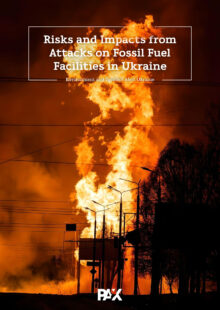Risks and Impacts from Attacks on Fossil Fuel Facilities in Ukraine
28 juni 2023Download 4.98 MB
Throughout the history of modern warfare, the targeting of fuel infrastructure has been part of military operations, whether for strategic reasons or simply as revenge. Examples are numerous, from the Allied Operation Tidal Wave against Nazi Germany in 1943, to Saddam Hussein’s Iraq’s scorched-earth tactics to set fire to over 700 Kuwait oil wells in 1991, to the last decade’s strikes by both the US-led Joint Coalition and Russia against oil fields and related infrastructure controlled by the Islamic State group in Syria.
Regardless of the military advantage, these operations often come with huge environmental and public health costs. The oil fires in Kuwait, for instance, resulted in a drop of over 10°C in the nearby region. While this was an extreme case, such attacks often have more localized impacts on human health and ecosystems, both immediate and long-term. These range from direct exposure to pollutants from the noxious fumes released to affected groundwater and soils, to accumulation of a range of toxic and hazardous substances found in oil products, including heavy metals. Timely identification and monitoring of these effects is therefore essential for the rapid assessment, clean-up, and remediation of affected areas, as well as providing insights as to the wider implications of warfare on the environment and livelihoods.
Since the start of the Russian invasion of Ukraine, the latter’s energy and fuel infrastructure has been one of Russia’s main targets. The use of fuel for airplanes, tanks, armored vehicles and trucks is essential for the Ukrainian armed forces, while power plants are key to keep a range of military and governmental facilities running. Often, the Russian strikes also targeted civilian fuel depots, as many smaller towns and cities have their own oil tanker farms for energy use for domestic, industrial and agricultural purposes. In turn, the Ukrainian army also took strategic military actions aimed at destroying fuel depots intended for the military needs of the invading army, targeting fuel depots located in the occupied1 territories of Crimea and eastern Ukraine.
This Environment and Conflict Alert aims to analyze environmental and health risks stemming from those attacks against Ukraine’s oil and gas infrastructure. Based on open-source information and satellite imagery analysis, the report takes stock of the damage inflicted upon the country’s fuel infrastructure, with two specific case-studies examined in detail. It then provides an overview of the associated environment and health risks caused by air, soil and water pollution resulting from this damage. The report concludes with recommendations for further assessment and remediation work to be supported by the international community.






